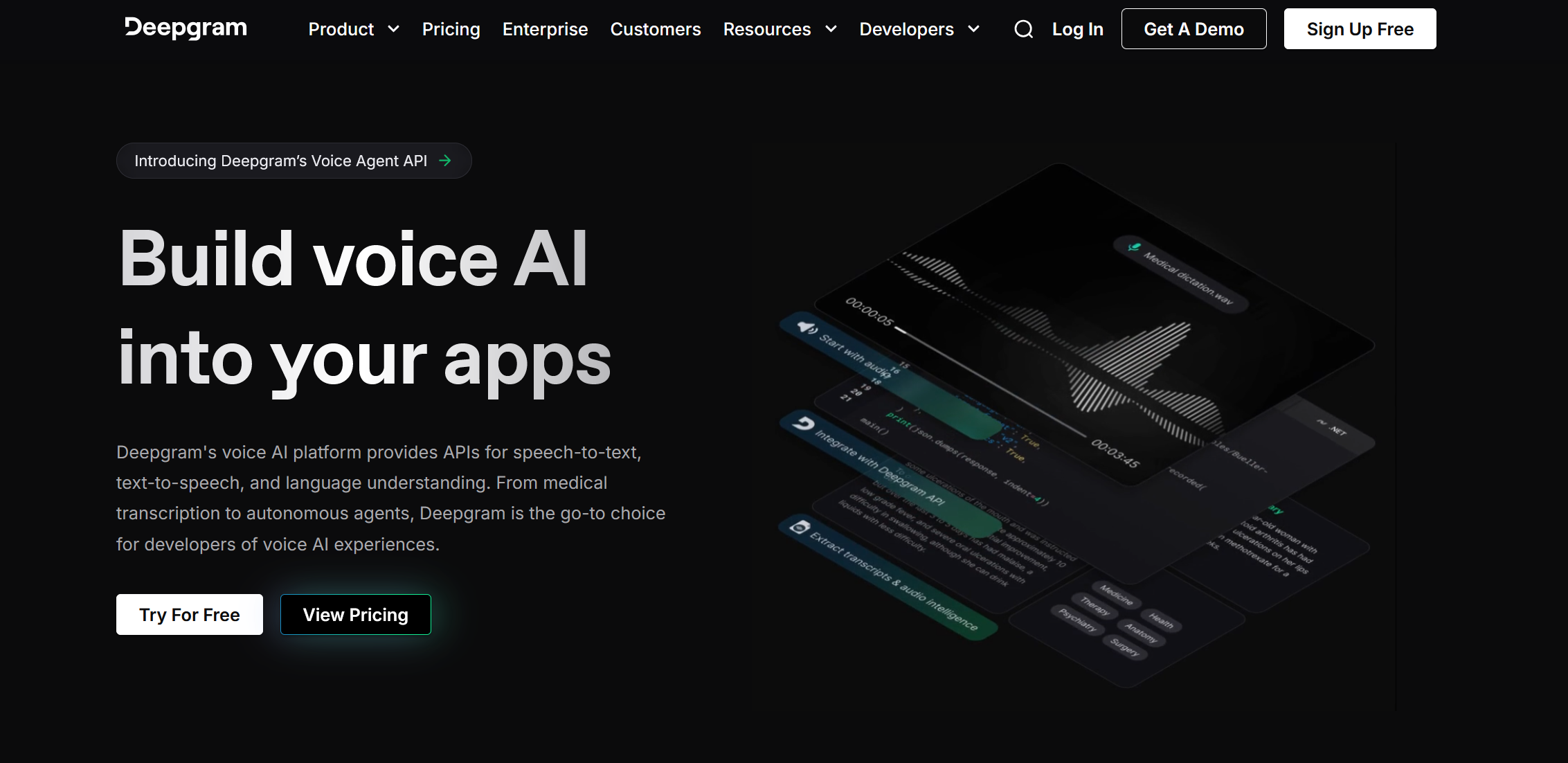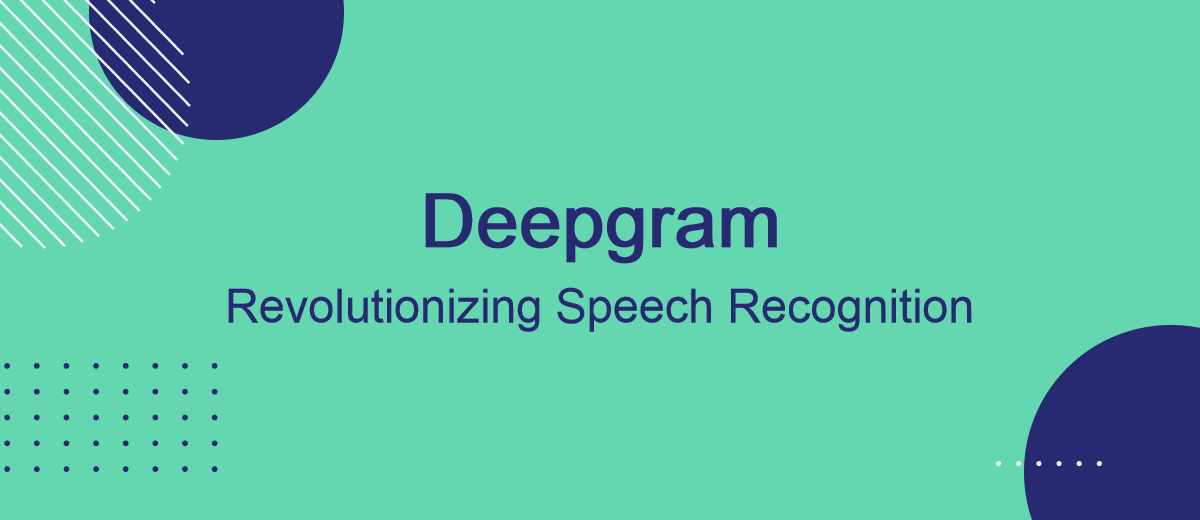AI is helping users automate many tasks that were done manually. One of these processes is speech-to-text and text-to-speech using generative AI models. This article will explore the Deepgram service's capabilities and applications. It has made great strides in this field.
What is Deepgram?
Deepgram is a platform offering speech recognition and text processing tools for creating transcriptions and voiceovers using deep learning algorithms. The San Francisco-based company of the same name developed it and has been running the project since 2015. Its advanced text-to-speech and speech-to-text technologies provide users with accurate, fast, and scalable transcription and speech generation services for various industries and applications.
Deepgram transcribes audio recordings in real-time and returns the generated text via an API request. It can also perform these actions in reverse order. The system’s algorithms support 30+ languages and 40+ file types, transcribing hour-long recordings in 8 seconds. Additionally, it summarizes, analyzes sentiment, and identifies content topics.
Deepgram offers a diverse and comprehensive range of pricing plans for the platform’s various services. The main ones are three package plans. They provide full access to speech-to-text, text-to-speech, and audio intelligence AI models and endpoints. These include:
- Pay As You Go ($200 in free credits, top up as needed, up to 100 concurrent speech-to-text requests, 5 Deepgram Whisper Cloud requests, 40 API WebSocket connections, 2 batch API requests, and 10 Deepgram Audio Intelligence requests).
- Growth (Prepaid $4-10k annually; credits are used as resources are consumed, up to 100 concurrent speech-to-text requests, 5 Deepgram Whisper Cloud requests, 80 API WebSocket connections, 3 batch API requests, and 10 Deepgram Audio Intelligence requests).
- Enterprise (For companies with large data volumes and/or extended deployment/support requirements, pricing is upon request).
Throughout its operations, Deepgram has raised over $100 million in venture capital funding. The largest round of $72 million occurred in 2022 as part of Series B, setting a record for AI speech developers.


How Deepgram's Technology Works
The platform's architecture enables a fast and efficient process for converting speech to text and vice versa. This process has several stages. First, the original audio is digitized. Then, it is split into small chunks for analysis. Then, AI models in the platform automatically process these segments. They extract features and patterns.
The extracted elements are then passed to deep learning algorithms, which generate a text transcription based on the data. The final text is processed (sentiment analysis, summarization). It is then sent to the client app via API.
At the core of the service is the Deepgram Engine, which uses specially trained neural networks and deep learning models. Another key component is the Deepgram API. It supports automated, large-scale data transfers. It also integrates with external systems and apps.
As of 2024, the platform offers the following tools:
- Deepgram Voice AI Agent. A universal voice-to-voice API interface designed for developing AI voice agents that can listen, speak, and analyze speech in real time. Instant responses and natural voice generation allow them to engage in smooth conversations on various topics.
- Deepgram Text to Speech. The Aura deep learning model generates natural human speech from text with a latency of less than 250 ms. It automatically selects the appropriate tone, rhythm, and emotions, making it ideal for voice bots and conversational AI applications.
- Deepgram Speech to Text. The next-generation Nova neural network converts audio into text with a latency of less than 300 ms and is 22% more accurate than existing solutions, recognizing over 30 languages and dialects. The Whisper API interface supports built-in diarization, word-level timestamps, and larger file uploads.
- Deepgram Audio Intelligence. The language models here automatically perform various operations with speech data, including summarization, sentiment analysis, topic identification, and intent recognition. They adapt to specific topics and tasks, providing high-quality, fast insights.
Key Features of Deepgram

Some of the platform’s key features and capabilities include:
- AI transcription of audio recordings and live streams with high accuracy and fast data processing.
- Speech-to-text and text-to-speech conversion in 30+ languages with support for 40+ file formats.
- Low latency when processing streaming data — less than 250 ms for text-to-speech and less than 300 ms for speech-to-text tools.
- Built-in language models effectively filter, summarize, analyze, and perform other operations with text/audio.
- The Deepgram API easily integrates with various programming environments, including Node, Python, and JavaScript via SDK on GitHub. The platform also supports native integrations with the Microsoft ecosystem.
- Deep learning algorithms distinguish and separate multiple speakers in audio recordings and live streams, enabling their use in relevant tasks.
- The platform accurately identifies speech in many languages, as well as accents and dialects, even with background noise.
- Analytical functions perform in-depth analysis of text and audio content, precisely identifying its topic, sentiment, participants' intent, and other parameters.
- Users can flexibly customize language models by training them on their datasets. This allows neural networks to learn specialized terminology and increase accuracy for specific tasks.
To start using Deepgram’s tools, you need to connect and configure the platform’s integration with your client application via API. The service’s documentation includes a detailed guide on sending API requests, configuring authentication headers, and other features.
Use Cases
Deepgram’s tools are in high demand across many industries. Some of the main ones include:
- Customer Service. AI speech recognition, transcription, and voice generation tools help contact centers and support teams work better. Companies use them in chatbots, voice assistants, and virtual agents. These can automate customer communication. Transcription/analysis of messages and call recordings also helps monitor employee performance, identify trends, and improve customer service quality.
- Content Making. The platform brings significant benefits to media, journalists, bloggers, and anyone involved with content. Its tools automate transcription of podcasts and interviews, generate video subtitles, and more. Deepgram helps businesses and professionals create and analyze content faster.
- Research and Innovation. The platform can train and customize deep learning models with user data. This makes it valuable for scientists, researchers, and innovators. Text/speech recognition, analysis, and generation technologies are used in projects exploring new technologies and developing advanced AI applications.
- Data Analytics. Deepgram’s analytics features automate the collection and processing of large volumes of customer data and their interactions with products/services. The system's data gives companies insights to improve their products, engage audiences, and better target ads.
Future of AI-Powered Speech Recognition
As for the future of AI-driven speech recognition and transcription, these technologies are expected to see rapid growth in the coming years. Key areas for innovation include:
- Deeper personalization in AI-user interactions — AI will learn users' preferences and use this knowledge in its operations.
- The widespread adoption of deep learning-based speech-to-text and text-to-speech algorithms across various industries, including healthcare, finance, telecommunications, and more.
- The integration of advanced AI tools in security and data protection systems, such as biometric authentication using voice recognition.
- Deeper integration of AI into assistive technologies, like smart home systems and screen readers.
- The proliferation of voice-controlled interfaces, which are highly useful for people with disabilities.
Deepgram's AI tech has greatly improved audio data processing. Its automated speech recognition and transcription are now much better. Deepgram’s products free users from time-consuming manual labor, providing significant economic efficiency. This service has strong advantages. It makes it a top AI provider in text-to-speech and speech-to-text processing. The company continues to innovate and improve its services, regularly introducing cutting-edge solutions for businesses and professionals.
Also read on our blog:
- Comprehensive Review: Exploring the AI Capabilities of Databricks
- Perplexity AI: The AI-Powered Search Engine Revolutionizing Information Access
- Moveworks: Revolutionizing Workplace Productivity with Generative AI
- Mastering Cohere: A Guide to Advanced AI Language Models
- Understanding Kaggle: A Beginner's Guide to the Data Science Platform
